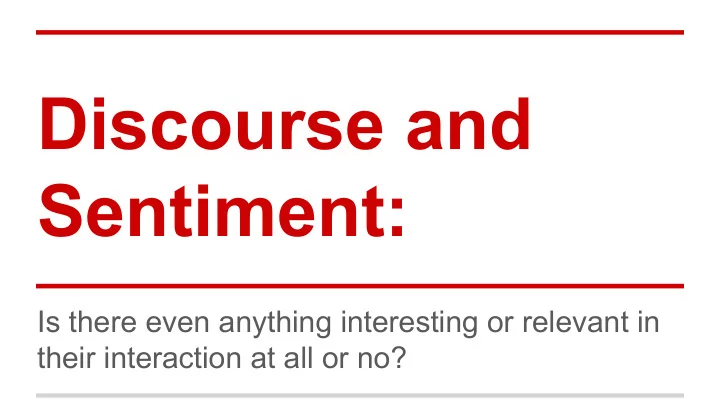

Discourse and Sentiment: Is there even anything interesting or relevant in their interaction at all or no?
Example We never feel anything for these characters, and as a result the film is basically just a curiosity.
Questions 1) Are there any interesting correlations between discourse relations or specific discourse markers and sentiment? 2) Can we leverage discourse and to provide polarity scores for values of attributes?
Polarity shift Rarely does the overall polarity of a sentence differ from the polarity of the second discourse segment. Polarity of sentence and segment # of sentences Same 795 Different 137 (too little sentiment to tell) 1372
Polarity of values for attributes One minute, you think you’re watching a serious actioner ; the next, it’s as though clips from The Pink Panther Strikes Again and/or Sailor Moon have been spliced in.
Since We haven't seen such hilarity since Say it isn't so! It 's the funniest American comedy since Graffiti Bridge. Crush could be the worst film a man has made about women since Valley of the Dolls.
Because The latest installment in the Pokemon canon, Pokemon 4ever is surprising less moldy and trite than the last two, likely because much of the Japanese anime is set in a scenic forest where Pokemon graze in peace.
Future Work ● See if we can’t automatically extract the attributes and values ● Get an annotated corpus where discourse relations hold inter-sententially and learn the sentiment relationship between the first and second segments
References ● Chomsky, N., & Halle, M. (1968). The sound pattern of English. ● Chomsky, N. (1965). Aspects of the Theory of Syntax (No. 11). MIT press. ● Chomsky, N. (1986). Knowledge of language: Its nature, origin, and use . Greenwood Publishing Group. ● Chomsky, N. (2002). Syntactic structures . Walter de Gruyter. ● Chomsky, N. (1995). The minimalist program (Vol. 28). Cambridge, MA: MIT press.
References ● Grosz, B. J., & Sidner, C. L. (1986). Attention, intentions, and the structure of discourse. Computational linguistics , 12 (3), 175-204. ● Pitler, E., Raghupathy, M., Mehta, H., Nenkova, A., Lee, A., & Joshi, A. K. (2008). Easily identifiable discourse relations. Technical Reports (CIS) , 884. ● Socher, R., Perelygin, A., Wu, J. Y., Chuang, J., Manning, C. D., Ng, A. Y., & Potts, C. (2013). Recursive deep models for semantic compositionality over a sentiment treebank. In Proceedings of the Conference on Empirical Methods in Natural Language Processing (EMNLP) (pp. 1631-1642). ● Marcu, D. (1997, July). The rhetorical parsing of natural language texts. In Proceedings of the 35th Annual Meeting of the Association for Computational Linguistics and Eighth Conference of the European Chapter of the Association for Computational Linguistics (pp. 96-103). Association for Computational Linguistics.
Recommend
More recommend